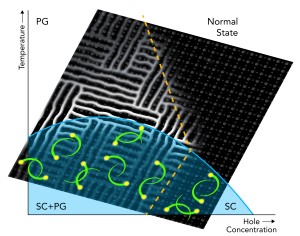
Experiments at SLAC have produced the first direct evidence that the pseudogap competes for electrons with superconductivity over a wide range of temperatures at lower hole concentrations (SC+PG). At lower temperatures and higher hole concentrations, superconductivity wins out.
Credit: SLAC National Accelerator Laboratory
A new study out of the SLAC National Accelerator Laboratory shows the “pseudogap” phase – a mysterious phase of matter – hoards electrons that might otherwise conduct electricity with 100 percent efficiency.
Scientists state that this pseudogap phase competes with high-temperature superconductivity, which robs electrons that would otherwise pair up to carry current though a material.
The results of the study are a culmination of 20 years of research aimed to find out whether the pseudogap helps or hinders superconductivity.
The study shows that the pseudogap is one of the things that stands in the way of getting superconductors to work at higher temperatures for everyday uses – thus making electrical transmission, computing, and other areas less energy efficient.
This from SLAC National Accelerator Laboratory:
In the experiments, researchers used a technique called angle-resolved photoemission spectroscopy, or ARPES, to knock electrons out of a copper oxide material, one of a handful of materials that superconduct at relatively high temperatures – although they still have to be chilled to at least minus 135 degrees Celsius.
Plotting the energies and momenta of the ejected electrons tells researchers how they were behaving when they were inside the material. In metals, for instance, electrons freely flow around and between atoms. In insulators, they stick close to their home atoms. And in superconductors, electrons leave their usual positions and pair up to conduct electricity with zero resistance and 100 percent efficiency; the missing electrons leave a characteristic gap in the researchers’ plots.
While scientists still do not know what causes the pseudogap, the results pave new directions for future research.
“Now we can model the competition between the pseudogap and superconductivity from the theoretical side, which was not possible before,” said lead author of the study Markoto Hashimoto. “We can use simulations to reproduce the kinds of features we have seen, and change the variables within those simulations to try to pin down what the pseudogap is.”
If scientists can remove the competition between the pseudogap phase and superconductivity, they may be able to raise the operation temperature – and efficiency levels – of these superconductors.
Want to get more info on superconductors? Head over to the Digital Library and check out the latest research!

